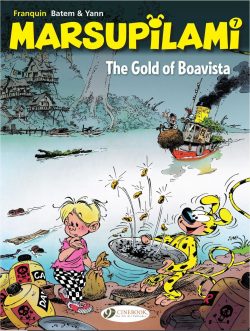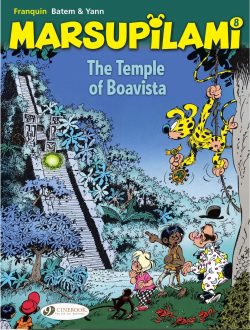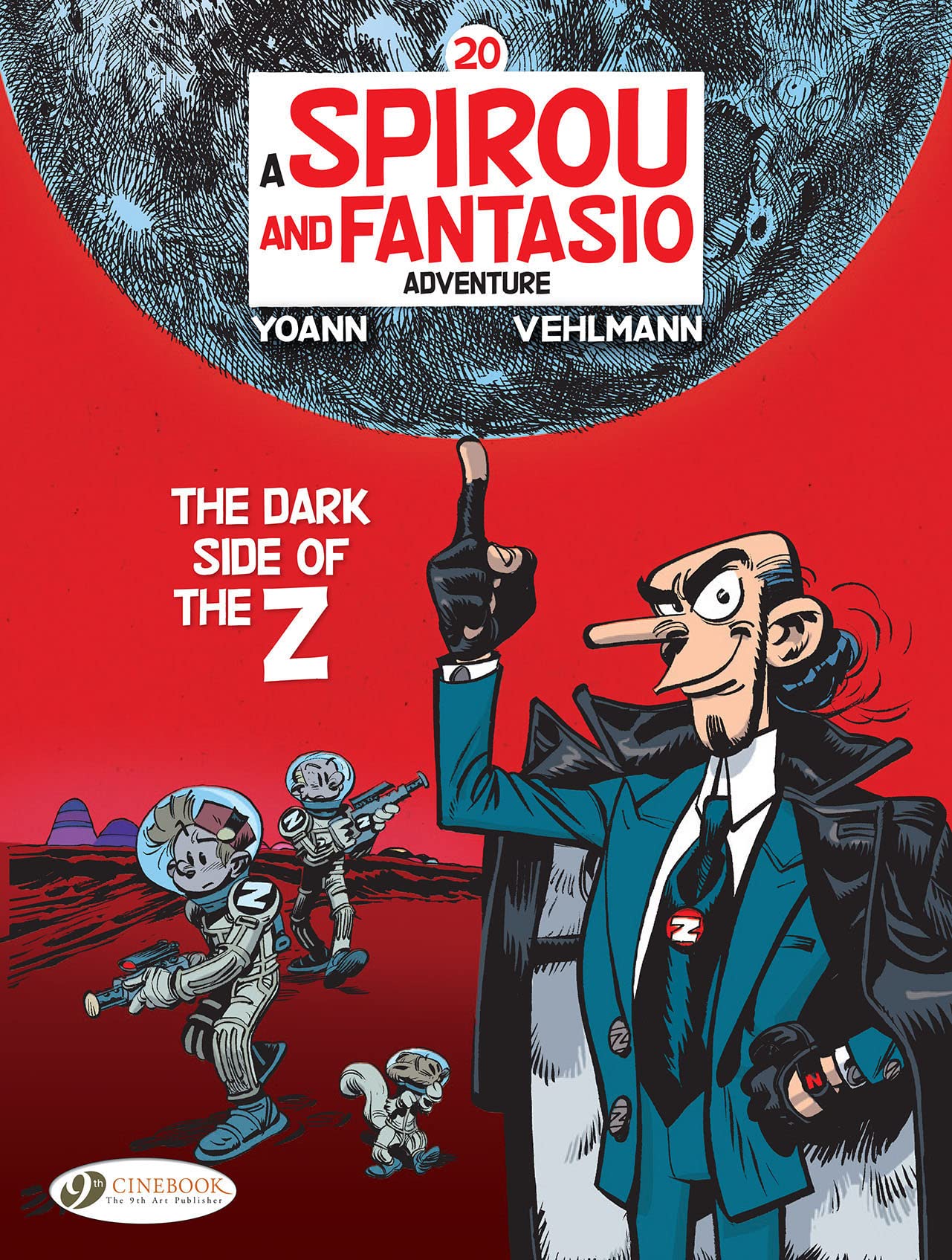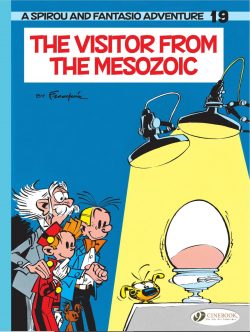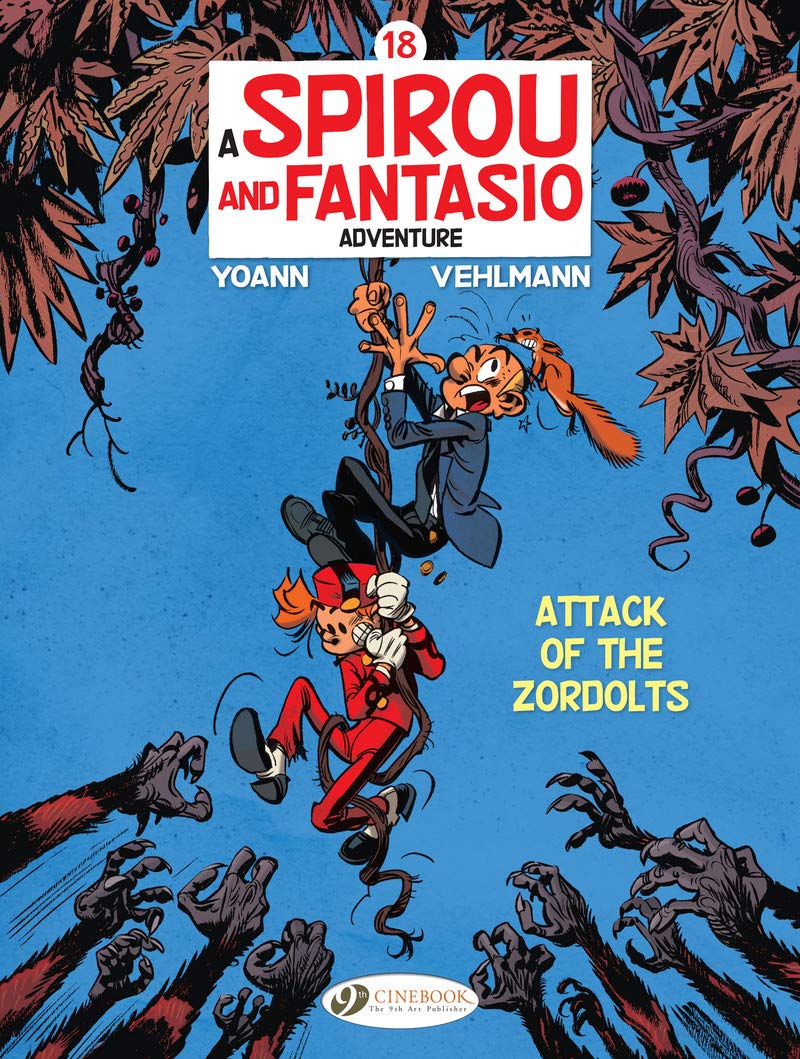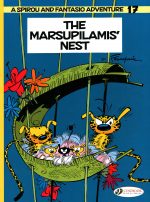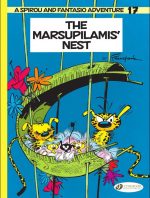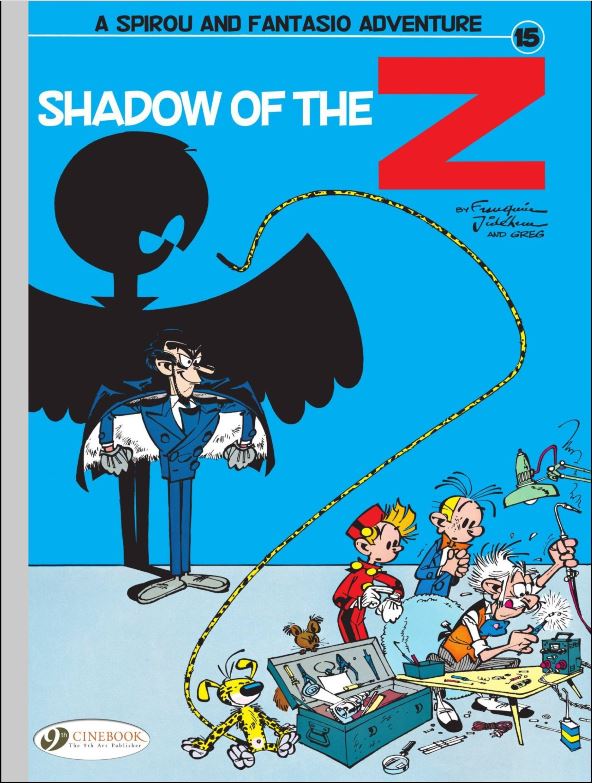
By Yoann & Fabien Vehlmann, designed by Fred Blanchard & coloured by Hubert: translated by Jerome Saincantin (Cinebook)
ISBN: 978-1-80044-162-0 (Album PB/Digital edition)
This book includes Discriminatory Content produced in less enlightened times. This book also includes Discriminatory Content included for comedic and literary effect.
Boyish hero Spirou (which translates as both “squirrel” and “mischievous” in the Walloon language) was created by French cartoonist Françoise Robert Velter AKA Rob-Vel. This was before World War II for Belgian publisher Éditions Dupuis, in response to the phenomenal success of Hergé’s Tintin at rival outfit Casterman. Soon-to-be legendary weekly comic Le Journal de Spirou launched on April 21st 1938 with a rival red-headed lad as lead feature in an anthology which bears his name to this day. The eponymous hero was a plucky bellboy/lift operator employed in the Moustique Hotel – in reference to the publisher’s premier periodical Le Moustique. The bellboy’s improbable adventures with pet squirrel Spip gradually evolved into far-reaching, surreal comedy dramas.
Spirou and his chums helmed the magazine for most of its life, with a cohort of truly impressive creators carrying on Velter’s work, beginning with his wife Blanche “Davine” Dumoulin who took over the strip when her husband enlisted in 1939. She was assisted by Belgian artist Luc Lafnet until 1943, when Dupuis purchased all rights to the property, after which comic-strip prodigy Joseph Gillain (Jijé) took the helm. In 1946, his assistant André Franquin assumed the creative reins: gradually ditching the well-seasoned short gag format in favour of epic adventure serials. He also expanded the cast, introducing a broad band of engaging regulars such as reporter Fantasio, phenomenally popular magic animal Marsupilami, master of mushroom Pacôme Hégésippe Adélard Ladislas de Champignac (the Count of Champignac) and one of the first strong female characters in European comics. Renamed Cellophine for Cinebook’s English translations, rival journalist Seccotine – of the tabloid The Moustic – became a regular foil and plays a key role in this very modern thriller…
Franquin was followed by Jean-Claude Fournier who updated the feature over nine stirring sagas tapping into the rebellious, relevant zeitgeist of the times: tales of environmental concern, nuclear energy, drug cartels and repressive regimes. By the 1980s, however, the series seemed outdated and lacking direction, so three separate creative teams alternated on it. Eventually overhauled and revitalised by Philippe Vandevelde (writing as Tome) and artist Jean-Richard Geurts AKA Janry. Adapting, referencing and in many ways returned to the beloved Franquin era and ethos, the strip found its second wind.
Their sterling efforts revived the floundering feature’s fortunes, generating 14 wonderful albums between 1984 and 1998. When the strip diversified into parallel strands (Spirou’s Childhood/Little Spirou and Guest-Creator Specials A Spirou Story By…), the team on the core feature were succeeded by Jean-David Morvan & José-Luis Munuera. Then Yoann & Vehlmann took over the never-ending procession of amazing adventures…
Multi-award-winning French comics author Fabien Vehlman was born in 1972, began his comics career in 1996 and has been favourably likened to René Goscinny. He’s probably still best known for Green Manor (illustrated by Denis Bodart), Seven Psychopaths with Sean Phillips, Seuls (drawn by Bruno Gazzotti and available in English as Alone), Wondertown with Benoit Feroumont and Isle of 1,000,000 Graves with Jason.
Yoann Chivard was born in October 1971 and drawing non-stop by age five. With qualifications in Plastic Arts and a degree in Communication from the Academy of Fine Arts in Angers, he became a poster/advertising artist whilst just dabbling in comics. His creations include Phil Kaos and Dark Boris for British Indie publications Deadline and Inkling, Toto l’Ornithorynque, Nini Rezergoude, La Voleuse de Pere-Fauteuil, Ether Glister and Bob Marone and he has contributed to Trondheim & Sfar’s Donjon. In 2006, Yoann was the first artist to produce a Spirou et Fantasio one shot Special. It was scripted by Vehlmann…
As globe-trotting journalists, Spirou and Fantasio regularly voyage to dangerously exotic places, uncover crimes, explore the fantastic and clash with exotic archenemies like Fantasio’s deranged and wicked cousin Zantafio and maddest of Mad Scientists, Zorglub. In 2011 one adventure (vol. 20 The Dark Side of the Z) saw Zorglub abduct them to the Moon where Spirou became a werewolf in a resort playground for the ultra-super-rich. It’s also – as we see here – where they first met their most insidious, pitiless and realistic supervillain…
As Spirou & Fantasio – dans les griffes de la vipère this cautionary tale from 2013 was the 53rd collected album in a series collectively approaching a landmark 100 volumes…

As Spirou chills out at a collectors market he meets excitable fan Annie: an adventure-hungry child determined to a roving reporter one day. The shy hero’s ego boost soon takes a hard knock however, as news comes that their magazine is being sued for inciting violence in children. The day in court is a disaster as seductive, bellicose lawyer Miss Jones, hired by affronted parents, makes the troubleshooters look like monsters, runs rings around Fantasio’s counsel and wins a million Euros in compensation from the deflated defendants. With ruin staring them in the face, the shocked wanderers wonder what they can do next. Miraculously, Spirou gets a visitation from his greatest hero…
Based on LJdS co-star Jean Valhardi, “Detective-Explorer” Gil Braveheart was downcast Spirou’s inspiration when he was growing up, and has again come to the rescue, offering to find a new investor to save the magazine…
He soon puts S&F in touch with an investment fund that will pay the parents off and fund continued publication, but as the heroes foolishly breeze past all the pages of a vast contract, Spirou sees old frenemy Cellophine being threatened by two very burly men-in-suits. All her efforts though cannot stop the lads signing on with the Viper Corporation…
Now paid incomprehensible amounts of money every month, Spirou and Fantasio initially flounder before simply giving it away to charities and good causes, but soon become bored as exploits and adventures apparently dry up. Soon after, Braveheart invites Spirou to visit Viper’s higher ups in their paradisical Marmalade Islands super resort and at last the canny crusader wises up. He’s blindly strolled into the most devious trap ever devised…
Again confronting one of the idle, petty super-rich magnates he’d met and disrespected on the Moon, Spirou realises all the power of money has been utilised to neutralise his friends and allies, obtrusively surveille his entire life and manipulate him into contractually and legally surrendering all aspects of his own life. He’s a brand of the corporation now and will do what he’s told when he’s told to, just like all the other heroes the top plutocrat has spitefully obtained in his constant search for meaning and validation and to counter his overwhelming boredom…
Trapped in a gilded cage and denied nothing except liberty, autonomy, fresh thrills and fun, Spirou refuses to bow to the admittedly heavenly, sybaritic life. Even sad broken Gil Braveheart’s admonishments can’t stop him making a bid for freedom, evading all the bugging tech and brutal heavies money can buy by recruiting brave Annie to act as his long-distance agent…

And then, after much preparation Spirou makes his break and the chase is on all over the Earth, but as the reporter seeks sanctuary, his flight across the globe and the way Viper treats ordinary people begins to inspire long-corrupted heroes and a way is found to reverse the intolerable situation. It’s not legal but it is unassailable and unstoppable…

Rocket-paced, action-packed, compellingly convoluted and with just the right blend of absurdity and helter-skelter excitement, In the Clutches of the Viper is a wry romp that is also genuinely terrifying, capturing the zeitgeist of modern concerns about the power of unchecked wealth and influence – and lawyers! This is pure cartoon gold, truly deserving of reaching the widest audience possible.
© Dupuis 2013, by Vehlmann, Yoann. All rights reserved. English translation © 2025 Cinebook Ltd.













